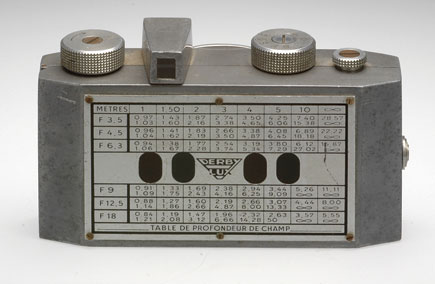The Gallus Derby Lux; On The Strength Of The Lens Cap Alone… Page 2
Screwed (not riveted) to the back, there’s a vast, engraved, paint-filled light-alloy depth of field scale marked “Table du profondeur du champ.” “Table” is easy enough; “profondeur” is “depth” (our word “profound” is related); and “champ” is “field,” as in the Champs Elysées or Elysian Fields. Who said French is difficult to understand?
Set the shutter speed (lift-twist-and-drop the knurled ring) and cock the shutter, which appears to use variable slit width at a constant tension, Leica-style, to vary the speeds. The index mark is not in the same place, cocked and uncocked, so don’t cock it first—or if you do, make an exposure with the lens cap on (there’s no double-exposure prevention) and start again. Marked speeds are 1⁄25, 1⁄50, 1⁄75, 1/100, 1/200, 1/500 plus B, but the B works only intermittently on my camera.
You have to twist the shutter cocking knob until it is fully wound. If you let go halfway through winding it springs back, though it is self-capping so it won’t expose the film if you do let go. Fire the shutter, using either the body release just under the shutter cocking dial or the cable release socket. To use the latter you need a cable release thin enough to thread through the hole in the front plate, just below the finder and to its left when the panel is collapsed.
 |
|
|
|
 |
Now wind on the film (or you may forget) but don’t cock the shutter: the protruding release is virtually certain to fire the camera while the front is collapsed, though this shouldn’t matter as long as the lens cap is in place—which may be why it was still there when I bought the camera.
The only thing I haven’t mentioned so far is the viewfinder, a squinty reverse-Galilean affair giving an image about half size, which at least makes it quite bright. There is no parallax compensation of any kind: you have to guess. The finder looks as though it is blanked off on both sides from a 645 or 6x9 version, perhaps from another camera in the range. There is no accessory shoe, though there is a 1⁄4” tripod socket on the bottom.
An interesting point is that there is extraordinarily little steel in the body: just about everything that can be made of light alloy, pot metal, or brass is. The film rollers, a few screws and pins, and the springs tested out (with a magnet) as steel: even the X-struts are light alloy. This is, I suspect, a result of the same postwar shortage of steel in Europe that led to the original Land Rover, with its Birmabright light-alloy bodywork. There is a tremendous amount of labor in the camera, from the little square bellows to the paint-filled engravings to the way it is stitched together with tiny screws, bespeaking an era when skilled labor was a lot cheaper than it is today: one of those asides that delight the hearts of the historically minded.
What’s it like to use? I don’t know. My most recent 127 film expired in ’56, and I didn’t feel like mail-ordering anymore, just to find out what the results are like. It’s hardly the most convenient camera on earth, and I’d not expect a lot from what appears to be a triplet that is anything up to 60 years old, though from the color of some of the reflections, it may be internally coated. If I were going to use it, I’d want to have the lens out and clean it, because it’s quite murky on the inside, and I fear that I might damage the coating if I tried, if of course it is coated.
Also, although the shutter cocks and fires, I don’t have that much faith in the shutter speeds. In fact, as I said at the beginning, I’d not have bought it if it hadn’t been for that magnificent lens cap, engraved and filled with red paint, staring out at me. The moustachios; the pigtails; the winged helmet: it’s all there. I don’t normally give my cameras names, but this one is called Asterix
the Gaul.
For further information on the artand craft of photography from RogerHicks and Frances Schultz, go to www.rogerandfrances.com.
- Log in or register to post comments

































